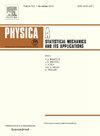Adaptive multi-parameter constrained time-delay feedback tri-stable stochastic resonance combined with EEMD for rolling bearing fault diagnosis
IF 2.8
3区 物理与天体物理
Q2 PHYSICS, MULTIDISCIPLINARY
Physica A: Statistical Mechanics and its Applications
Pub Date : 2025-02-01
DOI:10.1016/j.physa.2024.130334
引用次数: 0
Abstract
In this paper, we propose a method that combines Ensemble Empirical Mode Decomposition (EEMD) with a Multi-parameter Constrained Time-delay Feedback Tri-stable Stochastic Resonance (MCTFTSR) system. We discuss its performance for fault signal diagnosis characterized by non-stationarity, multi-components, and multi-interferences. Initially, we propose and study MCTFTSR system driven by Gaussian white noise and periodic signal. Following that, the equivalent potential function, steady-state probability density (SPD), mean first passage time (MFPT) and spectral amplification coefficient (SA) of MCTFTSR system are derived by using the small time-delay approximation. Next, we discuss the impact of parameters on MCTFTSR system from the perspectives of particle residence probability, transition and output characteristics. Subsequently, we employ numerical simulations to contrast the output performance of the MCTFTSR, MCTSR, and TFSTSR systems. The results indicate that, in comparison to the other two systems, MCTFTSR exhibits superior detection performance under various driving frequency signal, Gaussian noise and Levy noise. Additionally, we simulate faulty AM signal to assess the applicability and superior detection capabilities of the EEMD-MCTFTSR method. It is found that the method can enhance and extract the characteristics of AM signals, to identify faults effectively. Finally, the proposed method is applied to practical engineering and compared with the EEMD method, MCTFTSR method. Genetic algorithm (GA) is used to obtain the optimal parameter combination and ensure the most effective fault signal detection. In the inner ring fault diagnosis, the SNRI of the proposed method is 0.54 dB and 7.6 dB higher than that of EEMD and MCTFTSR, respectively, while in the outer ring fault diagnosis it is 3.02 dB and 8.05 dB higher. The results show that the EEMD-MCTFTSR method exhibits superior denoising and signal extraction capabilities compared to the other two methods, which further enhances the application of SR in bearing fault diagnosis.
求助全文
约1分钟内获得全文
求助全文
来源期刊
CiteScore
7.20
自引率
9.10%
发文量
852
审稿时长
6.6 months
期刊介绍:
Physica A: Statistical Mechanics and its Applications
Recognized by the European Physical Society
Physica A publishes research in the field of statistical mechanics and its applications.
Statistical mechanics sets out to explain the behaviour of macroscopic systems by studying the statistical properties of their microscopic constituents.
Applications of the techniques of statistical mechanics are widespread, and include: applications to physical systems such as solids, liquids and gases; applications to chemical and biological systems (colloids, interfaces, complex fluids, polymers and biopolymers, cell physics); and other interdisciplinary applications to for instance biological, economical and sociological systems.

 求助内容:
求助内容: 应助结果提醒方式:
应助结果提醒方式:


